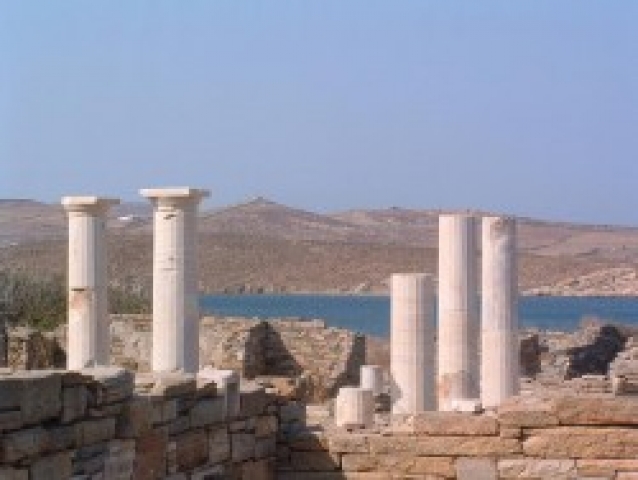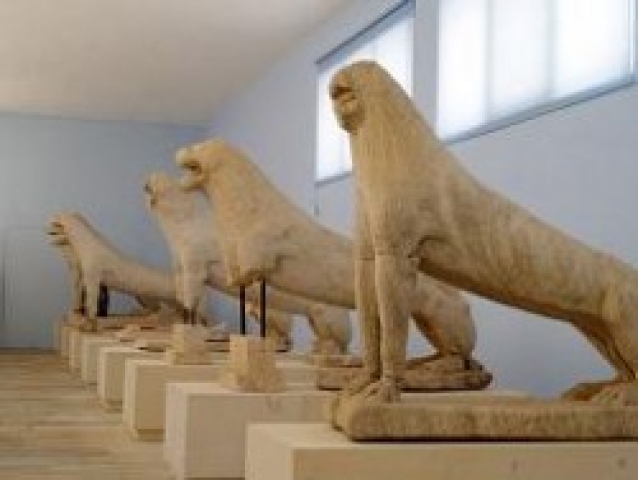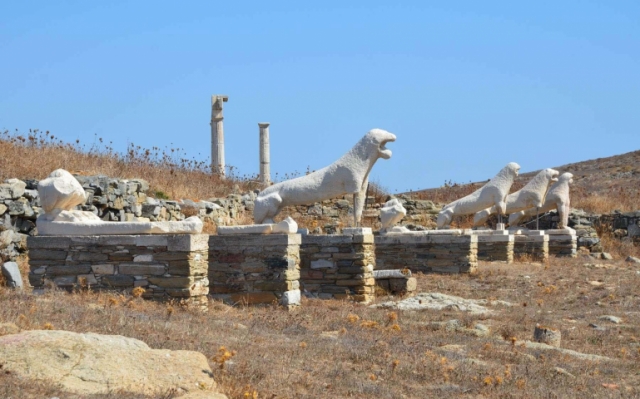Press here.
Places near Fourni
This long structure once held a giant trireme, the flagship of Antigonus II Gonatas, which he offered as a dedicatory display, to celebrate the victory at Kos against the Ptolemaics in 255 BC.
Oikos translates roughly as "family unit," and this building was meant to connect the "family" of Naxos to the family of Apollo. The Naxians had been building temples here since the 7th century BC, but this ruin primarily dates from the 6th century and later. (If you look closely, you can see a couple of holes in the exposed bedrock within the courtyard. These would have held the original wooden columns of the first building.) The Oikos was most famous for its huge statue of Apollo, nearly 8 meters tall, which tumbled over in a huge storm sometime in the 4th century BC. Although it was later re-erected, time, pirates, and the elements have reduced it to a couple of very worn lumps of brilliant white marble.
A gamma-shaped structure, situated on the southwest side of the Sanctuary of Apollo, in contact with the Propylaea.
in this house they found the headless statues of the owners, Dioskourides and his wife Cleopatra, a couple from Athens; they were erected in 138 BC by Cleopatra after the death of her husband; French archaeologists chose to name the house after her, a decision which increases the number of visitors, but disappoints those of them who believed there was a link between the location and Cleopatra VII, the famous Egyptian queen. Cleopatra is a Greek name meaning "glory of her father".
Mt. Cynthus
If you visit Delos consider hiking to this hill, you get a view of almost the entire island and a sense for how important the place was historically.
One of the three temples of Apollo, built by the Athenians and specifically by Peisistratos around 530-510 BC. The temple was housing a statue of Apollo. It is the oldest of the three temples of Apollo.
On the left from the harbor is the Agora of the Competialists (circa 150 BC), members of Roman guilds, mostly freedmen and slaves from Sicily who worked for Italian traders. They worshiped the Lares Competales, the Roman "crossroads" gods; in Greek they were known as Hermaistai, after the god Hermes, protector of merchants and the crossroads.
Agora of the Competialists, an open yard, surrounded by shops, small temples and altars, is the first monument that the visitors see, entering the archaeological site of Delos. Here were the stores of the merchants of the association of Roman citizens and liberalized slaves, who worshiped the gods of the "crossroads", the Lares Competales. However, the market served also other traders, Hermaists and Apolloniasts.
A temple dedicated, probably, to the mythic Greek goddess Tyche (meaning "luck" in Greek), who was the personification of fortune, prosperity and wealth. The Roman equivalent was the goddess Fortuna.
Delos Archaelogical Museum
The Delos Museum was built in 1904, with the expense of the Athens Archaeological Society. The original building included the five western rooms, plus several more in 1931 and 1972. In the same period there have been huge, but unfortunate, modifications in the appearance of the building.
The present exhibition contains nine galleries: six of them contain sculptures and reliefs found on Delos, one of the best collections in the world. Two rooms hold pottery dating to the prehistoric and late-hellenistic periods and a final room showcases the various miniature objects found in the private homes of Delos. The exhibition is not yet complete.
Collections
The most important collections include:
Statues and columns of the 7th - 1st century BC
Vases of instruments of the 3rd millennium - 1st century BC
Idols 2nd - 1st century BC
Jewelry and small items of 2nd - 1st century BC
Mosaics of 2nd - 1st century BC
Exhibits
The key exhibits include:
a plate with ivory relief of Mycenean warrior that was found in Artemision
a torso Kouros from the temple of Apollo
a marble cluster Vorrea which snaps the princess of Attica Oreithyia and was located in the temple of Athens
statues belonging to Dioskouridi and his wife, Cleopatra -- Athenians living in Delos - found at the home of the couple, in the area of theatre,
a statue of Apollo in the press of the Lyceum of Praxitelous Apollo - the god based in the trunk of a tree and clicks on Gallic shields - from the area of theatre,
a bronze facade bearded Dionysus who diadima bodies and ivy wreath and found south of the Market Kompetaliaston, Corinthian alabaster - a vase for perfumed oil with a Potnias Thiron between two swans - found in Iraio,
a headed triangular pedestal Kouros statue - with relief head crushed in a corner gorgoneia and the other two - from the Temple of Apollo,
an Archaic daughter, which is decorated in the middle of the front with vertical film debossed double meandros - found in the Temple of Apollo, and is considered one of the oldest existing large plastic,
a fresco from the outside wall of a house in the area where Skardana represented by Hercules, and two pygmachoi male form plays flute or trumpet.
Public tank, constructed to collect water from the river Inopos, the sacred river of Delos, that its springs were on the Mt. Kynthos and also believed to contact underground with the river Nile in Egypt. The water used for the ceremonies of the Egyptian sanctuaries.
This temple of Apollo is chronologically the second one that was built in the sanctuary. Tough to imagine, but this humble pile of rubble used to be one of the more impressive monuments on the island. Started by the Athenians when they controlled Delos, sometime around 475 BC, it wasn't finished for another hundred years or so.
In this area there are temples that are dedicated to Egyptian Gods.
Group of private dwellings, named for the seasonal stream, Inopos, one of the only ones on the island. The waters were sacred, and were supposed to flow directly from the waters of the Nile River in Egypt.
Residential and commercial district. Most structures date from around the second or third century BC. Strolling up the road, you really get a good impression of what the ancient settlement was like. Actually, it's very much like walking the narrow streets of Mykonos. Minus the gay bars, of course.
One of the more complete houses. Mosaics feature theatrical masks, and a stunning floor with the god Dyonysus riding on a panther
The monumental gateway leading to the sacred precinct of Apollo. The version that survives (basically just the massive marble platform and a few doric column stumps) was built by the Athenians when they still controlled the island--with tacit approval from the Romans--in the 2nd century BC.
This was a Sanctuary built by Egyptian merchants, around 200 BC. It was the place of worship of the ancient Greek-Egyptian god Sarapis (or Serapis) and goddess Isida, and later Anubis and Horus, who was called by the ancient Greeks Arpokratis
It was the sanctuary of the Syrian gods, built probably around the middle of the 2nd century BC. This sanctuary was the place of worship of goddess Atargate and her partner Adas.
A temple dedicated to the ancient Greek god Apollo, also being invoked as Pythios (Pythian Apollo), an epithet due to his association with the site of the Delphic oracle.
It is located on the west side of the Sacred Way and was a commercial arcade with many shops. It was constructed by the Greek King Philippos V of Macedonia.
There are two tombs, the tomb of Argi and Opida and the tomb of Laodiki and Yperochi. They are associated with the worship of the mythical Hyperborean (northernmost) Virgins and the myth of goddess Leto. Hyperborean Virgins were the daughters of Hyperborean people whose origin is unclear.
A temple dedicated to ancient Greek goddess Demeter, also being invoked as Thesmophoros.
The Minoan Fountain was a rectangular public well, hewn in the rock, with a central column; it formalized the sacred spring in its present 6th century BC form, reconstructed in 166 BC, according to an inscription.
Probably the most photographed spot on the island, not for any historical reason, but for the giant phallic statues that front this ruin. Supposedly built by a guy named Carystios (who probably would have enjoyed the nightlife on neighboring Mykonos) around 300 BC.
A temple dedicated to the ancient Greek god Zeus and goddess Athena.
Delos is the sacred island of the Ancient Greek, which according to mythology, was revealed among the waves of the Aegean to Leto, who was being chased by the jealous Hero; it was the refuge where she gave birth to Apollo and Artemis.
On Delos the admirably well-preserved ruins of one of the largest, most significant, and best- organized ancient Greek settlements are found. The island was first settled, probably by the Kares, about the 3rd millennium B.C. In the beginning of the 8th cent. B.C. it developed into a center of worship and was the capital city of an amphictyony of Aegean island.
At the end of the 6th cent B.C., the tendency of the Athenians was to take over the island: IN 540 B.C. Peisistratos ordered the first purification of the sanctuary. As a result of the second purification (426 B.C.) the entire contents of all the islands graves were remove to neighboring Rhenia. Afterwards in order to prevent desecration of the sanctuary, both births and deaths were forbidden on the island of Apollo.
The Athenians consecrated the first “Delia” dedicated to Leto, Artemis, and Apollo. In 315 B.C., when Macedonians arrived on the island, Delos achieved its independence and developed commercially.
During the Roman period, the island thrived, until, until 88 B.C.; the population included Egyptians, Syrians and Italians. Then, after two dreadful attacks during the Mithridatic War, Delos went into decline and was finally abandoned in the 6th cent A.D.
In 1873 the French Archaeological School of Athens started excavations and restoration to help the wealth of the island's history to be revealed. The Archaeological Museum of Delos houses one of Greece’s most important collections, including rare exhibits of ancient sculpture ceramic vessels, epigraphs and wonderful mosaics etc.
The sites of Delos and Rhenia are protected by the Ministry of Culture; thus, both the mooring of private boats there and staying overnight without official permission are strictly forbidden.
How to get there
There are daily trips to Delos, as long as the weather allows (connection by sea to Delos is difficult during winter or some summer days, mainly due to extreme wind conditions). During the high season trips to Delos are available from other islands of Cyclades as well (from Tinos and Naxos mainly).
Beyond the path that leads to the southern part of the island is the ancient theater, built in the early 3rd century BC in the elegant residential quarter inhabited by Roman bankers and Egyptian and Phoenician merchants.
It could seat over 5000 people. Most of the stage buildings are gone and the theater seating is fairly overgrown, but it's still easy to imagine how spectacular it must have been to see a performance in this setting. Of course during the latter Roman era, who knows what passed for "entertainment."
Excavations have unearthed the spectacular 3rd- to 5th-century mosaics of the Houses of Dionysus.
This natural fissure in the rock was probably one of the oldest sites of worship on the island, dating at least back to archaic times. Symbolically, the fissure was the womb from which the goddess gave birth to life. In the 3rd century BC giant slabs of rock were added to form a roof, or replace a natural covering that collapsed. Carved into the living rock at the back of the fissure is a small platform on which a statue of Herakles once stood. Being inside here at sunset is truly a mystical experience...but don't miss your boat or you'll be spending the night
Built by the Athenians between 425-417 BC, it is the most elaborate of the three temples of Apollo and the official temple of the Athenian Alliance.







